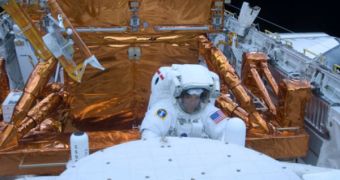Astronauts aboard the space shuttle Atlantis have just finished their second spacewalk yesterday, and managed to install six new sets of gyroscopes onto the 19-year-old space telescope. However, the very last box proved to have different dimensions than its holder, and so it could not be installed. But NASA had anticipated this problem, and had packed a set of refurbished gyroscopes, modified from some that were pulled off Hubble in 1991. Spacewalkers Michael Massimino and Michael Good struggled with the assembly for many hours, until they finally decided to call it quits and install the spare.
Hubble maintains its relative position in space and also that of its objectives on a certain point in deep space, by making use of six spinning gyroscopes. The instruments ensure that the observatory remains on course, and that its cameras and other tools are always pointed in the correct direction. Over the years, three of these gyroscopes have failed, and the telescope, until Atlantis got there, ran on only two, because mission controllers had decided to keep at least one to spare.
The move was necessary because, otherwise, if all of the devices had failed, there would have been nothing keeping the telescope in orbit. Initially scheduled to last only six and a half hours, the spacewalk concluded two hours later, because NASA pressed Massimino and Good to also replace three of Hubble's six batteries. The power supply has never been changed, and Hubble flew with its original set since 1990.
One of the main reasons why mission controllers pushed the astronauts so hard into replacing the batteries as well was because changing the gyroscopes and the batteries were the main objectives of the STS-125 mission. With the Wide Field Planetary Camera 3 (WFPC3) installed, the observatory can now continue to work for at least another five years, astronomers hope. During the spacewalk, which in the end lasted more than eight hours and 56 minute (the 8th longest in history), astronauts had to change the oxygen and battery supplies in their suits several times, in order to be able to complete the tasks.
During the first spacewalk, another team of astronauts managed to replace the WFPC2 with its modern counterpart, to affix a new docking bay to the telescope, and also to repair an offline data handling unit. In future spacewalks, Atlantis' crew will attempt to repair the Advanced Camera for Surveys, Hubble's main and most important instrument, which has been shut down since 2007. In addition, three sets of batteries have to be replaced as well, and a new thermal insulator coating applied overall.

 14 DAY TRIAL //
14 DAY TRIAL //